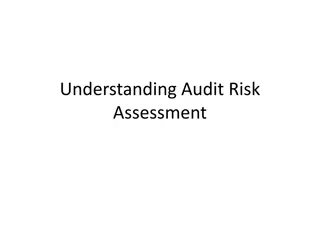Understanding Audit and Review Techniques for Improved Security
Exploring the importance of audit tasks like recording and reviewing logs in cybersecurity, this content delves into authentication, authorization, and audit mechanisms. It also highlights the uses of audits for individual accountability, event reconstruction, and problem monitoring. Different techniques for manual and automated review, as well as intrusion detection, are discussed, shedding light on the role of visualizations, interfaces, and response mechanisms in enhancing security measures.
Download Presentation

Please find below an Image/Link to download the presentation.
The content on the website is provided AS IS for your information and personal use only. It may not be sold, licensed, or shared on other websites without obtaining consent from the author. Download presentation by click this link. If you encounter any issues during the download, it is possible that the publisher has removed the file from their server.
E N D
Presentation Transcript
Lecture 23: Reviewing Logs CS 5430 4/23/2018
Classes of Countermeasures Authentication: mechanisms that bind principals to actions Authorization: mechanisms that govern whether actions are permitted Audit: mechanisms that record and review actions
Uses of audit Individual accountability: deter misbehavior Event reconstruction: determine what happened and how to recover Problem monitoring: real-time intelligence
Audit tasks Recording: what to log what not to log how to protect the log Reviewing: manual exploration automated analysis
Manual review Enable administrators to explore logs and look for {states, events} Issues: Designers might not have anticipated the right {states, events} to record Visualization, query, expressivity (HCI/DB issues) Correlation amongst multiple logs
Interfaces Flat text [example: last time's syslog] Hypertext [example] DBMS [example: queries in CMS] Graph (nodes might be entities like processes and files, edges might be associations like forking or times) [example]
Techniques Temporal replay: animate what happened when [example] Slice: display minimal set of log events that affect a given object
Automated review and response Review: detect suspicious behavior that looks like an attack, or detect violations of explicit policy Custom-built systems Classic AI techniques like training neural nets, expert systems, etc. Modern applications of machine learning Response: report, take action
Intrusion detection Intrusion detection system (IDS): automated review and response responds in (nearly) real time components: sensors analysis engine countermeasure deployment audit log
Example: Network monitoring Suspicious behavior: opening connections to many hosts Automated response: router reconfigures to isolate suspicious host on its own subnet with access only to (e.g.) virus scanner download, notifies administrators Issue: errors...
Errors False positive: raise an alarm for a non-attack makes administrators less confident in warnings perhaps leading to actual attacks being dismissed False negative: not raise an alarm for an attack the attackers get in undetected! Tradeoff between the two needs to be tunable; difficult to achieve the right classification statistics
Identification methodologies [Denning 1987] 1. Signature based: recognize known attacks 2. Specification based: recognize bad behavior 3. Anomaly based: recognize abnormal behavior
1. Signature-based detection A.k.a. misuse detection and rule-based detection Characterize known attacks with signatures If behavior ever matches signature, declare an intrusion Issues: Works only for known attacks Signature needs to be robust w.r.t. small changes in attack
Example: Snort # alert tcp $EXTERNAL_NET any -> $HOME_NET 53 ( msg:"OS-LINUX OS-LINUX x86 Linux overflow attempt ADMv2"; flow:to_server,established; content:"|89 F7 29 C7 89 F3 89 F9 89 F2 AC|<|FE|",fast_pattern,nocase; metadata:ruleset community; service:dns; classtype:attempted-admin; sid:265; rev:15; )
Network-based IDS Typically a separate machine Stealth mode: one NIC faces the network being monitored, no packets ever sent out on it, no packets can be routed specifically to it another NIC faces a separate network through which alarms are sent Honeypot: dedicated machines(s) or networks purpose is to look attractive to attacker but actually just a trap: monitored to detect and surveil attacker
2. Specification-based detection Characterize good behavior of program with a specification If behavior ever departs from specification, declare an intrusion Issues: Effort to create specifications Any program is a potential vulnerability if executed by a privileged user
Example: Distributed Program Execution Monitor (DPEM) [Ko et al. 1997] Monitors Unix audit logs Analyst writes grammar in DSL to describe good behavior Parser checks conformance of logs with grammar Distributed because it combines information from multiple hosts
3. Anomaly-based detection Characterize normal behavior of system If behavior ever departs far enough from normal, declare an intrusion Issues: Feature identification Obtaining data on what is normal
Statistical models Threshold models: min and max Moment models: mean and standard deviation Markov models: probability of next event based on current state Seems like a job for machine learning
Machine learning Despite extensive academic research, Machine learning [for IDS] is rarely employed in real world settings [Sommer & Paxson 2010] ML is great for classification: finding similarities ML is not as great at outlier detection: here, normal vs. abnormal ML in adversarial setting not well understood
Identification methodologies Signature based: recognize known attacks Specification based: recognize bad behavior Anomaly based: recognize abnormal behavior 1. 2. 3.
Intrusion handling [Northcutt 1998] 1. Preparation 2. Identification 3. Containment 4. Eradication 5. Recovery 6. Follow up
Automated response Monitor: collect (additional) data Protect: reduce exposure of system Alert: call a human
Counterattack Legal: file criminal complaint Technical: damage attacker to stop attack or prevent future attacks Might harm an innocent party Might expose you to legal liability

















































